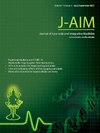偏头痛的阿育吠陀疗法--病例报告。
IF 1.7
Q3 INTEGRATIVE & COMPLEMENTARY MEDICINE
引用次数: 0
摘要
偏头痛是导致全球功能性残疾的最普遍原因之一。偏头痛患者会出现不同程度的头痛,与较高程度的残疾有关,是由心理和生理压力引发的。据估计,偏头痛影响着全球 16.6% 的人口,女性患偏头痛的几率是男性的三倍。尽管现代医学和传统医学都取得了长足的进步,但仍无法彻底治愈偏头痛。在阿育吠陀医学论文中,偏头痛被归入 "Shiroroga"(与头部有关的疾病)分类下的 "Ardhavabedhaka"。35 岁的印度男性警务督察在过去三个月中反复出现右侧半颅骨头痛,三天一次,症状为 Tridhoshaja Ardhvabhedaka(偏头痛),伴有 Amlapitta(胃酸过多)。在对患者进行全面评估后,根据患者的 Dosha pradhanyatha 和 Vyadhi avastha(疾病阶段)精心制定了治疗方案。为了采用适当的 Samprapti vighatana、Nidana parivarjana(戒除致病因素)、Deepana、Paachana、Siravyadha、Nasya 和 Dosha ShamanaChikitsa 原则。此外,通过 MIDAS 和 NPR 评分评估偏头痛的严重程度,偏头痛评分随后从 19 分降至 4 分,NPR 评分从 8 分降至 2 分,直至治疗干预结束。本病例报告明确强调了阿育吠陀疗法在有效控制偏头痛方面的关键作用。总之,要有效治疗偏头痛,就必须正确评估 Dosha 状态和 Vyadhi avastha,并在疾病的适当阶段正确选择适当的药物和程序,如 Siravyadha 和 Nasya。本文章由计算机程序翻译,如有差异,请以英文原文为准。
Ayurveda management of migraine - a case report
Migraine is one of the most prevalent causes of functional disability worldwide. Migraine patients experience headaches of varying degrees, which are related with a higher level of disability and are triggered by psychological and physiological stressors. Migraine is estimated to affect 16.6% of the world's population, with women being three times more likely to experience it than men. Despite considerable advancements in modern and traditional medicine, a complete cure remains uncertain. In Ayurvedic treatises, migraine headache is referred to as Ardhavabedhaka under the classification of Shiroroga (diseases related to the head region).
35-year-old Indian male police inspector, suffering from recurrent right hemi-cranial headaches once in three days for the last three months, presented symptoms of Tridhoshaja Ardhvabhedaka (Migraine) associated with Amlapitta (hyperacidity).
After a thorough assessment of the patient, the treatment was meticulously planned based on the patient's Dosha pradhanyatha and Vyadhi avastha (stage of disease). For the proper Samprapti vighatana, Nidana parivarjana (abstinance from the eitiological factors), Deepana, Paachana, Siravyadha, Nasya and Dosha Shamana Chikitsa principles were adopted. Further, the severity of the migraine was assessed by MIDAS and NPR score, which subsequently decreased from 19 to 4, and the NPR scale decreased from 8 to 2 till completion of the therapeutic intervention.
This case report unequivocally highlights the pivotal role of the Ayurveda treatment regimen in effectively managing migraine. Overall, effective treatment of migraine cases requires the correct assessment of Dosha status and Vyadhi avastha and the correct selection of the appropriate medicine and procedures like Siravyadha and Nasya at that appropriate stage of the disease.
求助全文
通过发布文献求助,成功后即可免费获取论文全文。
去求助
来源期刊

Journal of Ayurveda and Integrative Medicine
INTEGRATIVE & COMPLEMENTARY MEDICINE-
CiteScore
4.70
自引率
12.50%
发文量
136
审稿时长
30 weeks
 求助内容:
求助内容: 应助结果提醒方式:
应助结果提醒方式:


